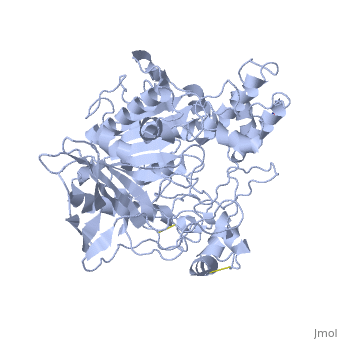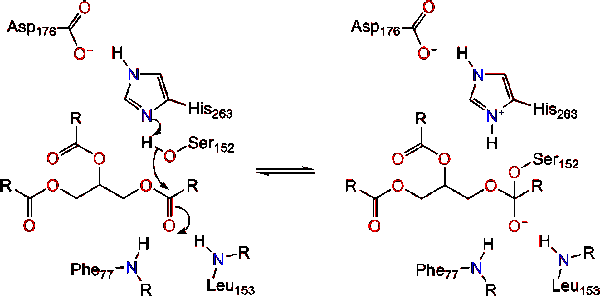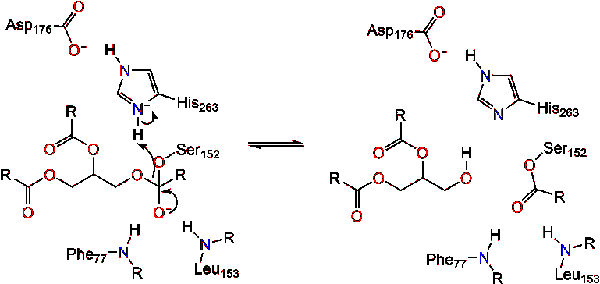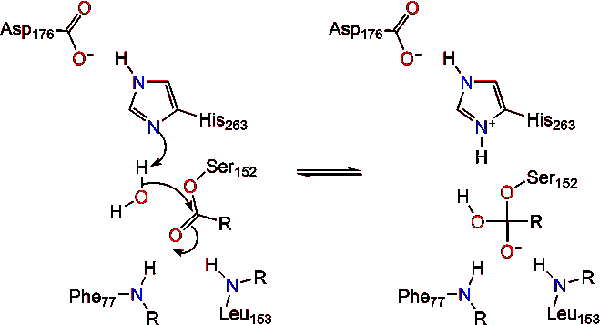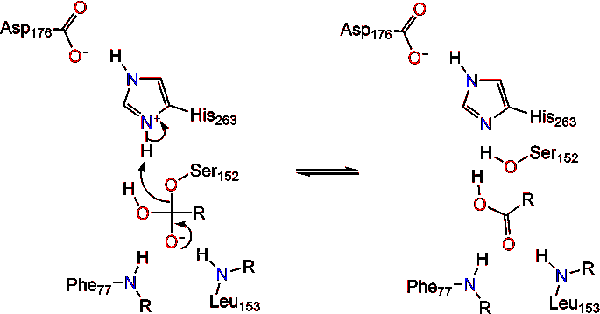Introduction
Lipase catalyzes the breakdown of lipids by hydrolyzing the esters of fatty acids. Its function is important for digestion and promoting absorption of fats in the intestines. Lipase is primarily found in and secreted by the pancreas, but is also found in the saliva and stomach.
- Pancreatic lipase (PDB ID: 1hpl) which is pictured to the right, is a carboxylic ester hydrolase. It is also commonly called pancreatic triacylglycerol lipase and its enzyme class number is E.C. 3.1.1.3 [1].
- The bile salt-stimulated lipase (BSSL) is found in breast milk.
- The hormone-sensitive lipase (LIPE) hydrolyzes a variety of esters. For details see Hormone sensitive lipase.
- Monoacylglycerol lipase (MAGL) hydrolyzes intracellular triglycerides to fatty acid and glycerol. MAGL functions together with LIPE. For details see Monoglyceride lipase.
The reaction catalyzed by the enzyme is shown below.

Further breakdown ultimately results in 2-monoacylglycerols and free fatty acids [2]. An in depth discussion of the mechanism can be found in the Lipase Catalytic Mechanism section. The determination of the structure and function of lipase was a gradual process. Lipase activity was first demonstrated in the pancreas by Claude Bernard in 1846. However, it wasn't until 1955 that Mattson and Beck demonstrated a high-specificity of pancreatic lipase for triglyceride primary esters [3]. In recent years, determination of the crystal structure of pancreatic lipase has become the primary focus as many scientists have worked to further this.
See also
Structure
Pancreatic lipase is a 50 kDa protein. While the crystallographic asymmetric unit contains two identical chains, information (REMARK 350) in the data file 1hpl indicates that the dimer is a crystallization artifact, and that the functional form (also called the biological assembly) is a single chain (monomer). The chain consists of 449 residues [4]. The s of lipase (in one subunit) include 102 residues which create 13 alpha helices, shown in red, and 139 residues involved in beta sheets totaling 28 strands, shown in gold. The alpha helices account for 22% of the protein, while the beta sheets comprise 30%. Each chain contains two well defined . The N terminal domain, shown in blue, is characterized by an alpha/beta hydrolase fold. While the C terminal domain, shown in green, contains a beta sheet sandwich which interacts with colipase [5]. Each monomer and dimer structure of lipase are held together by disulfide bonds, hydrogen bonds, and electrostatic interactions (salt bridges). Lipase has 12 total between cysteine residues. are formed between the positively charge nitrogens (blue) in Arg and Lys, and negative oxygens (red) in Asp and Glu residues. (in yellow) also stabilize the enzyme between main chain and side chain atoms. Lipase has a distinct distribution of residues (purple spacefill represents polar residues). Hydrophobic collapse contributes to much of the secondary and tertiary structures, as the (shown in white) make up the interior of the protein, while polar residues (transparent blue) are on the surface [6]. In addition, lipase has two . One is buried in each monomer subunit. The calcium ion is essential to protein folding and enzyme activity [7]. The image shows the green calcium ion in subunit A, coordinated by Glu187, Arg190, Asp192, and Asp195 residues. The Ca(+2) charge is stabilized by negatively charged glutamate and aspartate residues, and the oxygen atoms from two water molecules (pink).
In addition, lipase has a unique (green) that blocks solvent from entering the active site (red). The lid is a 25-residue helical structure that protects the oxyanion hole. The lid (yellow) is especially important to substrate binding as it undergoes a dramatic shift that alters the secondary structure of the lipase binding site from a (active site in red) to an (active site in blue, triacylglyceride in spacefill) [8] (see Lipase lid morph for an animation of this transition). The lid opening is accompanied by a change in secondary structure from a mostly beta-extended confirmation to a structure where more than half the active site is formed from alpha helices [9].
Colipase Coenzyme
Lipase is activated by colipase, a coenzyme that binds to the C-terminal, non-catalytic domain of lipase. Colipase is a 10kDa protein that is secreted by the pancreas in an inactive form. It has five conserved (shown in yellow) [10], and 2 - a hydrophilic surface (site of lipase C-terminal interaction- shown in blue) and a hydrophobic surface (contains multiple hydrophobic loops to bridge the lipid- shown in white)[11]. Trypsin will then activate colipase before the cofactor can interact with lipase.
Colipase must be present for activation of lipase and acts as a bridge between lipase and the lipid. When colipase binds, active lipase is stabilized for the hydrophobic interaction with triacylglycerides [12]. Without colipase present, the accumulation of amphiphiles at the oil/water interface in the duodenum would prevent pancreatic lipase from binding to its substrate. [13]. Colipase and lipase are opposite of the active site on the C-terminal (contacts are regions of pink and yellow, with water molecules shown in darker blue). The enzymes are bound by polar interactions such as , and [14].
In the presence of colipase, the enzyme is activated which moves the (shown in red, active site in green) which is composed of amino acids 216-239. The N-terminal flap moves in a concerted fashion along with the C-terminal domain to reveal the active site (green), allowing it to bind with a substrate. It is hypothesized that this flexibility may have significance in binding the colipase-lipase complex with the water-lipid interface.[15] The reorganization of the flap also induces a second conformational change that creates the oxyanion hole.[16]
Lipase Catalytic Mechanism
Lipase activation at the lipid-water interface of triacylglycerides, in the presence of colipase and bile salts, is known as interfacial activation. For the hydroloysis reaction to take place, colipase anchors lipase to the lipid-water membrane of the micelle which causes a surface change on lipase. Colipase's four hydrophobic loops interact with the hydrophobic atmosphere of the triacylglyceride. This initiates active site binding to the lipid, and lid opening to reveal a more hydrophobic environment for the triacylglycerol. This in turn, allows the triacylglycerol to interact with key active site residues like the catalytic triad. A diverse array of lipase enzymes can be found in nature. Though the different forms occupy diverse protein scaffolds, most are built upon an alpha/beta hydrolase fold[17][18] and possess a chymotrypsin-like comprised of an acidic residue, a histidine, and a serine nucleophile. In the case of horse pancreatic lipase, the catalytic triad is comprised of [19]. This catalytic triad functions like most found in nature. First, aspartic acid forms a hydrogen bond with His 263, increasing the pKa of the histidine imidazole nitrogen. This allows the histidine to act as a powerful general base and deprotonate the serine. The deprotonated serine then can serve as a nucleophile and attack the ester carbonyl of one of the fatty acids on the 1 or 3 carbons of the glycerol backbone of the lipid substrate. Upon attacking the lipid, a negatively charged tetrahedral intermediate is formed (Reaction 1). It is stabilized in the oxyanion hole by two residues: .
The carbonyl reforms with the glycerol backbone segment acting as the leaving group (Reaction 2).
A water molecule then donates a proton to the histidine, creating a reactive hydroxyl anion. The hydroxyl anion can then attack the carbonyl carbon of the lipid, forming another negatively charged tetrahedral intermediate which is stabilized in the oxyanion hole (Reaction 3).
Upon reformation of the carbonyl, the catalytic serine is released and monoglyceride and fatty acid monomers diffuse away (Reaction 4).
Inhibition of Pancreatic Lipase
(purple), a C11 alkyl phosphonate, is a competitive inhibitor of pancreatic lipase. It binds directly in the active site pocket. There are also five B-octylglucoside (gray and red) molecules which associate with lipase. MUP forms hydrogen bonds with : Ser 152 and His 263, which are part of the catalytic triad, and Phe 77 and Leu 153 which are the stabilizing residues located in the oxyanion hole [20].
MUP was shown to be by van der Waals contacts with hydrophobic side chains Ala 178, Phe 215, Pro l80, Tyr ll4, Leu 213 (shown in blue).
Protein - Substrate Interactions
Lipase binds with numerous hydrophobic contacts. As is seen here, the lipase interacts with the alkyl group of cholesteryl linoleate via a hydrophobic rift within the protein. This rift orients the molecule to optimize the lipolysis reaction.
Shown in this scene is lipase from the yeast Candida rugosa in with two molecules of cholesteryl linoleate (grey). The active site residues including Ser152, Asp176, and His263 are shown in red stick representation. Lipase can accommodate two lipid molecules due to the fact that it's two identical subunits catalyze an identical reaction. One lipase molecule can catalyze two lipolysis reactions at a time.
Clinical Significance
Pancreatic lipase is secreted into the duodenum through the duct system of the pancreas. In a healthy individual, it is at very low concentration in serum. Under extreme disruption of pancreatic function, such as pancreatitis or pancreatic cancer, the pancreas may begin to digest itself and release pancreatic enzymes including pancreatic lipase into serum. Measurement of serum concentration of pancreatic lipase can therefore aid in diagnosis of acute pancreatitis.[21]. Due to lipase's activity in the digestion and absorption of fat, there has been a growing market for lipase inhibitors for weight loss pharmaceuticals. The most popular is Orlistat (or Xenical®) which is a natural product from Streptomyces toxytricini and is the hydrogenation product of lipostation- an irreversible lipase inhibitor. This inhibitor also acts by binding Ser152, producing an ester which hydrolyzes so slow that it is practically irreversible [22].
3D Structures of Lipase
Lipase 3D Structures
